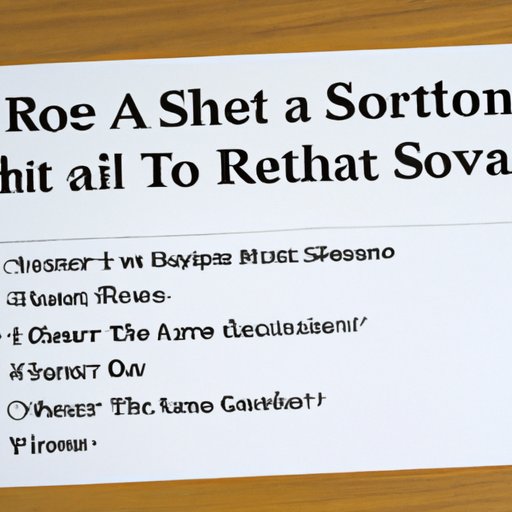Introduction
A Roth Individual Retirement Account (IRA) is a type of retirement savings account that allows you to save and invest your money on a tax-advantaged basis. A Roth IRA offers several benefits over other types of retirement accounts, including the ability to withdraw contributions at any time without penalty, as well as the potential to earn tax-free income on qualified withdrawals. In this article, we’ll explore the eligibility requirements, tax benefits, and steps for opening a Roth IRA, as well as investment strategies to maximize your retirement savings.
Eligibility and Tax Benefits
In order to be eligible to open a Roth IRA, you must meet certain criteria. According to the Internal Revenue Service (IRS), you must have earned income from wages, self-employment, or other sources, and you must not exceed certain income limits. The income limits are based on your filing status and adjusted gross income (AGI).
In addition to the eligibility requirements, there are certain tax benefits associated with a Roth IRA. Contributions to a Roth IRA are made with after-tax dollars, meaning that they are not deductible on your tax return. However, once the money is in the account, it grows tax-free, and qualified withdrawals in retirement are also tax-free. This means that you won’t pay taxes on the money when you withdraw it during retirement, which can provide significant tax savings.
Contribution Limits
The amount you can contribute to a Roth IRA each year is limited by the IRS. For 2021, the maximum contribution amount is $6,000 for individuals under age 50, or $7,000 for individuals age 50 and over. These amounts may change from year to year, so it’s important to stay up to date on the current contribution limits.
In addition to the regular contribution limit, the IRS also allows individuals age 50 and over to make what are known as “catch-up” contributions. These are additional contributions above the regular limit that can help you increase your retirement savings if you’re behind on saving for retirement. The catch-up contribution limit for 2021 is $1,000.

Steps for Opening a Roth IRA Account
Once you’ve determined that you’re eligible to open a Roth IRA, the next step is to choose a provider. There are many different providers available, ranging from banks and credit unions to online brokers and investment firms. It’s important to compare the fees and features of each provider before deciding which one is right for you.
Once you’ve chosen a provider, the next step is to gather the required documentation. This includes information such as your Social Security number, driver’s license, and bank account information. You may also need to provide proof of income if you’re contributing more than the annual limit. Once you’ve gathered all of the necessary documentation, you can open the account and fund it with cash or investments.

Traditional vs. Roth IRA Options
When deciding whether to open a Roth IRA or a traditional IRA, it’s important to consider the pros and cons of each option. With a traditional IRA, contributions are made with pre-tax dollars, meaning that they are deductible on your tax return. However, withdrawals in retirement are taxed as ordinary income. With a Roth IRA, contributions are made with after-tax dollars, but withdrawals in retirement are tax-free.
The decision of which option is best for you will depend on your individual financial situation. If you anticipate that you’ll be in a higher tax bracket in retirement, a Roth IRA may be a better option since you’ll be able to take advantage of the tax-free withdrawals. On the other hand, if you anticipate being in a lower tax bracket in retirement, a traditional IRA may be a better option since the contributions are tax-deductible.

Investment Strategies for a Roth IRA
Once you’ve opened a Roth IRA, the next step is to decide how to invest the money. One of the most popular strategies is asset allocation, which involves spreading your investments across different asset classes, such as stocks, bonds, and cash, in order to reduce risk and maximize returns. It’s important to regularly review and adjust your asset allocation to ensure that it remains aligned with your goals.
In addition to asset allocation, you can also invest in mutual funds or individual stocks. Mutual funds are professionally managed portfolios of stocks and/or bonds that offer diversification and professional management. Investing in individual stocks carries more risk, but also has the potential for greater returns. It’s important to do your research before investing in either type of security.
Benefits of Starting a Roth IRA Early
One of the biggest benefits of starting a Roth IRA early is the power of compounding interest. Compounding interest is the process of earning interest on both the original principal and the accumulated interest over time. The longer you keep your money in a Roth IRA, the more time it has to grow through compounding interest, which can result in significant gains over time.
In addition to compounding interest, a Roth IRA also offers tax advantages. Since contributions are made with after-tax dollars, withdrawals in retirement are tax-free. This can provide significant tax savings, especially if you anticipate being in a higher tax bracket in retirement.
Finally, a Roth IRA can provide peace of mind and security in retirement. By investing in a Roth IRA, you’ll have access to a steady stream of income in retirement, which can help you maintain your lifestyle and cover expenses. You’ll also have the flexibility to withdraw contributions at any time without penalty, giving you added financial security.
Conclusion
A Roth IRA can be a great way to save for retirement, offering tax-free growth and the potential for significant tax savings in retirement. To get started, you’ll need to determine if you’re eligible to open a Roth IRA, understand the contribution limits, and choose a provider. From there, you can develop an investment strategy that fits your goals and start taking advantage of the many benefits of a Roth IRA.
(Note: Is this article not meeting your expectations? Do you have knowledge or insights to share? Unlock new opportunities and expand your reach by joining our authors team. Click Registration to join us and share your expertise with our readers.)
